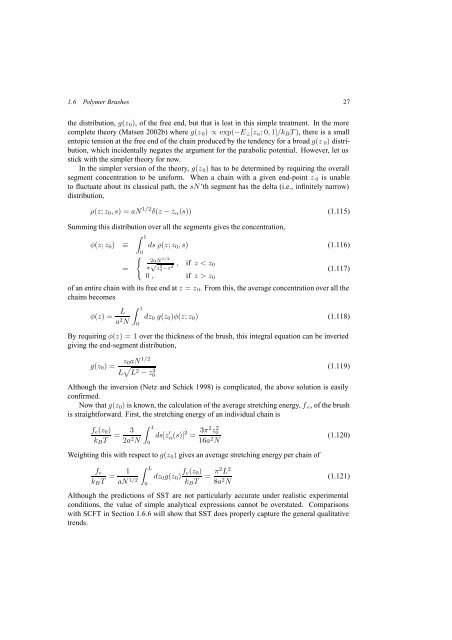Self-Consistent Field Theory and Its Applications by M. W. Matsen
Self-Consistent Field Theory and Its Applications by M. W. Matsen
Self-Consistent Field Theory and Its Applications by M. W. Matsen
You also want an ePaper? Increase the reach of your titles
YUMPU automatically turns print PDFs into web optimized ePapers that Google loves.
1.6 Polymer Brushes 27<br />
the distribution, g(z 0 ), of the free end, but that is lost in this simple treatment. In the more<br />
complete theory (<strong>Matsen</strong> 2002b) where g(z 0 ) ∝ exp(−E ⊥ [z α ;0, 1]/k B T ), there is a small<br />
entopic tension at the free end of the chain produced <strong>by</strong> the tendency for a broad g(z 0 ) distribution,<br />
which incidentally negates the argument for the parabolic potential. However, let us<br />
stick with the simpler theory for now.<br />
In the simpler version of the theory, g(z 0 ) has to be determined <strong>by</strong> requiring the overall<br />
segment concentration to be uniform. When a chain with a given end-point z 0 is unable<br />
to fluctuate about its classical path, the sN’th segment has the delta (i.e., infinitely narrow)<br />
distribution,<br />
ρ(z; z 0 ,s)=aN 1/2 δ(z − z α (s)) (1.115)<br />
Summing this distribution over all the segments gives the concentration,<br />
φ(z; z 0 )<br />
≡<br />
∫ 1<br />
ds ρ(z; z 0 ,s) (1.116)<br />
0<br />
{<br />
2aN<br />
1/2<br />
=<br />
√ , if zz 0<br />
of an entire chain with its free end at z = z 0 . From this, the average concentration over all the<br />
chains becomes<br />
∫ 1<br />
φ(z) =<br />
L<br />
a 2 dz 0 g(z 0 )φ(z; z 0 ) (1.118)<br />
N 0<br />
By requiring φ(z) =1over the thickness of the brush, this integral equation can be inverted<br />
giving the end-segment distribution,<br />
g(z 0 )= z 0aN 1/2<br />
L √ L 2 − z 2 0<br />
(1.119)<br />
Although the inversion (Netz <strong>and</strong> Schick 1998) is complicated, the above solution is easily<br />
confirmed.<br />
Now that g(z 0 ) is known, the calculation of the average stretching energy, f e , of the brush<br />
is straightforward. First, the stretching energy of an individual chain is<br />
f e (z 0 )<br />
k B T = 3<br />
2a 2 N<br />
∫ 1<br />
0<br />
ds[z ′ α(s)] 2 = 3π2 z 2 0<br />
16a 2 N<br />
Weighting this with respect to g(z 0 ) gives an average stretching energy per chain of<br />
(1.120)<br />
f e<br />
k B T = 1<br />
aN 1/2 ∫ L<br />
0<br />
dz 0 g(z 0 ) f e(z 0 )<br />
k B T = π2 L 2<br />
8a 2 N<br />
(1.121)<br />
Although the predictions of SST are not particularly accurate under realistic experimental<br />
conditions, the value of simple analytical expressions cannot be overstated. Comparisons<br />
with SCFT in Section 1.6.6 will show that SST does properly capture the general qualitative<br />
trends.
















